A case study from Scilly, October 2011 |
A 'case study' involving a Siberian Chiffchaff and a 'grey and white' (Bonelli's-like)
Chiffchaff present at same time on St
Agnes, Scilly
(with a note on so-called 'plumage morphing')
During October 2011, Chiffchaffs reaching St Agnes, Isles of Scilly, presented an instructive case-study in the variation among Chiffchaffs of presumed eastern origin, in the appearance of a classic tristis, and the confusion which genuinely 'grey and white' Chiffchaffs continue to present. During the third and fourth weeks of the month, Chiffchaffs reaching the island displayed a very wide range of plumages, with significant differences in the amount of olive and yellow in the plumage and in their overall 'paleness'.
On October 16th and 17th reports of 'pale Chiffchaffs' came from both the Troy Town and Lower Town areas, with suggestions in each case that the birds were 'Siberian Chiffchaffs'. However, the appearances of the two were radically different. Fortunately, both remained for several days, which enabled observers to make careful assessments and confirmations of plumage and calls, though both called rather infrequently.
The Troy Town individual exhibited pronounced 'brown and buff' plumage hues and an evenly-pitched, plaintive call, in keeping with Siberian Chiffchaff. Very much in contrast, the Lower Town individual proved to be an archetypal 'grey-and-white' Chiffchaff, with plumage hues very reminiscent of a Bonelli's Warbler P. orientalis / P. bonelli and with at least some calls typical of abietinus (and collybita). It later relocated to an ivy-covered wall near the Parsonage, where very detailed observations and close-up photographs were enabled.
The individual at Troy Town was first observed on October 16th by Derek Pratt, whose attention was drawn by the unfamiliar call, and he alerted Steve Addinall and Ken Shaw. From the information conveyed by Derek, Ken and Steve suspected that the bird might well be a Siberian Chiffchaff. Steve, with a good ear for calls, immediately equated the call with recordings of tristis to which he had listened previously. He likened the call to that of a Dunnock rather than to the often-cited Bullfinch, which agrees with my own interpretation (especially some of the Dunnocks on Scilly). Subsequently, the bird frequently fed out in the open on the ground in one particular field, which enabled prolonged and detailed observations by many birders. It remained for four days, until the 19th, and photographs were taken by various observers. I am indebted to Robin Hemming for permitting me to include three of his excellent images, which were taken in soft, shaded, late-afternoon light on October 17th using a high-quality DSLR, this optimal conditions for good colour balance. A fourth image, one of my own, was taken the following day using a 'bridge' camera. It is clearly of lesser quality but is included to illustrate that, despite two very different cameras used on different days, the variation in hues is only rudimentary and the over-riding appearance is consistent.
The Siberian Chiffchaff displayed no olive in the crown and mantle and no yellow away from the bend of the wing. In addition to these 'starting point' features for tristis, it also displayed a distinctive tan-brown hue to the crown and mantle and a warm buff wash to the supercilium, upper eye-ring, cheeks, and the sides of the breast and flanks (Plates 1a to 1d). On the cheeks and, in sunny conditions, this suffusion could take on a rusty or even pinkish hue. The characteristic 'brown and buff' hues in the plumage recalled Mountain Chiffchaff P. lorenzii, though the supercilium was strongly buff-suffused rather than whitish. The legs and bill were 'densely' black and the latter rather delicate. It required considerable patience to hear the bird call but, when it did so, the call was again classic tristis: a monosyllabic, evenly pitched 'eeep' or 'iiihp', fading at the end and with a characteristic plaintive quality.

Plate 1a
© Robin Hemming
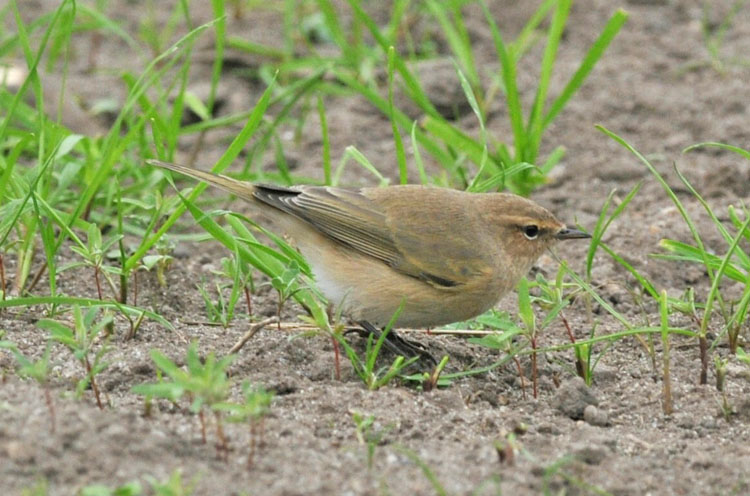
Plate 1b
© Robin Hemming
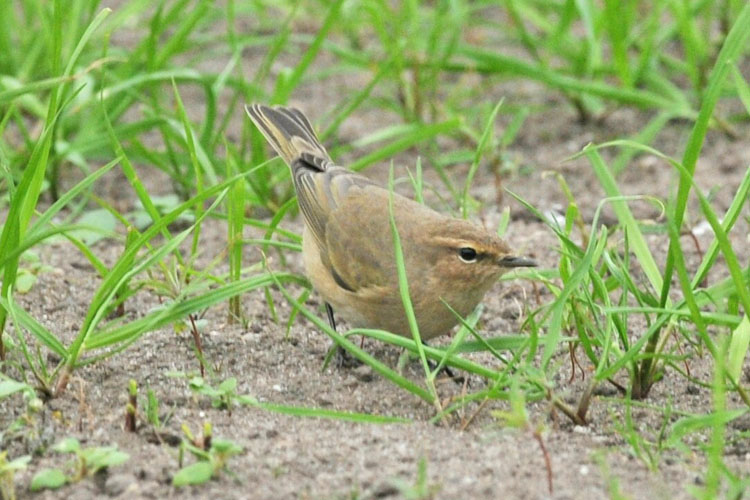
Plate 1c
© Robin Hemming

Plate 1d
© A. R. Dean
Compare the images above with photographs in the Gallery, which include unequivocal Siberian Chiffchaffs in Siberia and Kazakhstan. See also photographs of a Siberian Chiffchaff with equally pronounced 'brown' upperparts trapped at Languard in Suffolk, in November 2011, which was the first in Britain confirmed to have tristis mtDNA (not a guarantee of thoroughbred tristis but significantly supportive).
On October 16th, the same day as the Troy Town tristis was discovered, a 'very pale' Chiffchaff was reported near Lower Town, with suggestions that it was a Siberian Chiffchaff. When other observers caught up with this bird it was immediately evident that it did not have the necessary feature-set of a diagnosable Siberian Chiffchaff. Rather, it was a good example of a 'grey-and-white' Chiffchaff, the identity of which are still much debated. During prolonged observations on October 16th and 17th (totalling several hours), this individual called a number of times, uttering both a rising 'hweet', recalling abietinus/collybita, but also a rising and falling, sharply inflected 'sweeoo'. On October 27th and 28th, an identical (near-certainly the same) individual was seen at very close range (down to 3 or 4 metres) near the Parsonage and also behind the old observatory buildings. For observers for whom nominate collybita is the norm, it was indeed an arresting individual, with a dominant pale grey component to crown and mantle, markedly white underparts, bright green fringes to remiges and rectrices, and paler fringes to tertials. At such close range it was determined that there were fine olive streaks in the crown and mantle and a yellow tinge to the white ground-colour of the well-contrasting upper section of the eye-ring (Plate 2f). It was viewed in various light conditions (from semi-shade to bright sunlight) and in various surroundings (perched in bright green vegetation, to right out in the open and even on the ground on a concrete surface). There were the inevitable slight variations in hues accordingly, yet the strikingly grey-and-white components in the body plumage and bright olive-green (even yellow-green) fringes to the remiges were consistent in its appearance, during observations totalling well over two hours - see Plates 2a to 2e. The face pattern (with well-defined eye-stripe and broken eye-ring), short primary projection and slight, all-dark bill were clearly those of a Chiffchaff. However, the plumage hues of Chiffchaffs which are so strikingly grey-and-white (in a UK context), and evident olive fringes to the remiges, could be confused very easily with those of one of the Bonelli's Warblers P.bonelli / P. orientalis (see additional comments and images in the main text).
As noted in the main text, on the basis of their pale and grey, non-collybita-like appearance, such individuals have sometimes been assumed to be tristis but, in fact, they are phenotypically rather distant from a core-range Siberian Chiffchaff and, morphologically, they are closer to less-colourful examples of abietinus, particularly from the east of that form's range (Kees Roselaar and Lars Svensson in litt.). See Plate 5 below, Plates 7, 8 & 9 in the main text and some of the photographs of Chiffchaffs on the breeding grounds in Finland). On the Scilly individual, a rather long-looking tail also recalled abietinus. Such 'greyer' Bonelli's-like Chiffchaffs occurring in the UK, including the Scilly individual, may give an abietinus (& collybita) call, though southern races of Chiffchaff can combine a relatively grey and white livery with a tristis-like call (see comments in main text and also examples from Iran <here>). It has now been established that a Chiffchaff bearing brevirostris mtDNA reached Germany in 2022 while individuals with caucasicus mtDNA reached Germany (one) and the Netherlands (four) between 2015 and 2019 (van der Spek et al. 2025). Four Chiffchaffs with the mtDNA of menzbieri (hitherto regarded as restricted to very short-range movements) reached the UAE in 2019 and 2020 (Motteau et al. 2022). Thus, the Middle Eastern races of chiffchaff must certainly be considered when an enigmatic chiffchaff is encountered in western Europe.
A note on so-called 'plumage morphing'
‘Plumage morphing’ is a technical-sounding term for a commonplace issue : that birds look paler in adversely harsh light, owing to colour-dilution. This applies to most species but, when a species has a varied and well -patterned plumage, colour dilution will not overly distract from its diagnostic appearance. With relatively ‘plain’ species, it can be colour nuances rather than patterns which determine the diagnostic appearance. If these colour nuances become diluted, or even lost, in adversely bright light, then the diagnostic appearance can be temporarily lost. The Chiffchaff complex provides a prime example where colour nuances are a key element in diagnosis.
Thus, with Siberian Chiffchaff, the characteristic ‘brown and buff‘ hues can become suppressed temporarily when the birds are viewed in severe light conditions. The resulting appearance is correspondingly paler and greyer than the true appearance, when viewed in more-neutral light. Unfortunately, this so-called ‘plumage morphing’ has distracted from studies of genuine plumage variation among Chiffchaff taxa, especially tristis and abietinus, with totally misplaced suggestions that, for example, all chiffchaffs with relatively grey-and-white plumage are simply a product of ‘plumage morphing’. It should be self-evident that it is a complete non-sequitur to suggest that, because ‘brown and buff’ tristis can appear paler in bright light, that indicates that ‘grey and white’ Chiffchaffs do not exist. A simple question highlights why this is nonsensical. How do the advocates of ‘plumage morphing’ know that the perceived ‘grey and white’ appearance is not genuine? The answer is, of course, that with a genuine tristis this paler and greyer appearance is temporary and, when the light conditions revert to a more-neutral intensity, the chiffchaff reverts to its characteristic tan-brown and buff appearance. The paler and greyer appearance was transitory and not permanent. Suitably prolonged and careful examination of tristis will always reveal its true underlying characteristics. Digital photographs are even more susceptible to so-called 'plumage morphing' and, too often, statements are made about individual chiffchaffs based almost exclusively on after-the-event examination of photographs (taken in a fraction of a second), without the support of careful and prolonged examination in the field. Siberian Chiffchaffs should never be identified (nor dismissed) on fleeting views, which may not be representative of their genuine appearance. Nor should Chiffchaffs with a ’grey and white’ morphology be dismissed on brief views as a product of ‘plumage morphing’. Prolonged and careful examination is a prerequisite of all identifications.Anyone dismissing out-of-hand the reality and significance of relatively 'grey and white' Chiffchaffs, and failing to document them comprehensively, is missing an opportunity to advance understanding of the true diversity among the Chiffchaff complex, the variability of abietinus and the appearance of southern taxa (breeding in the Caucasus and Middle East) and their potential for reaching western Europe.

Plate 2a.
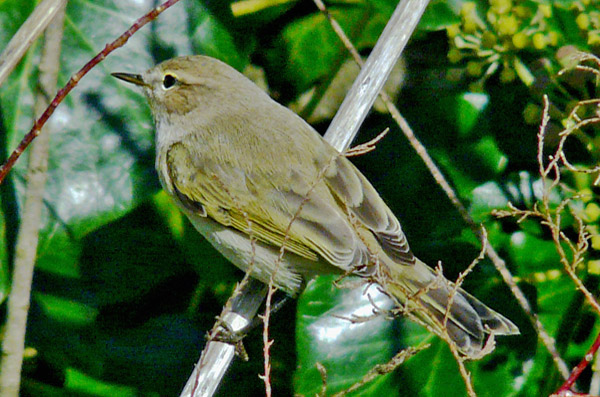
Plate 2b.
© A. R. Dean
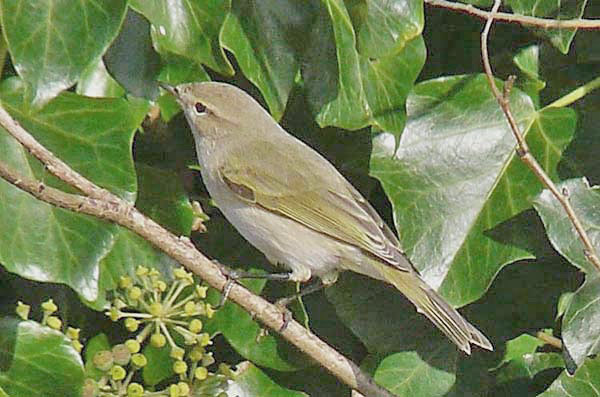
Plate 2c.
© A. R. Dean
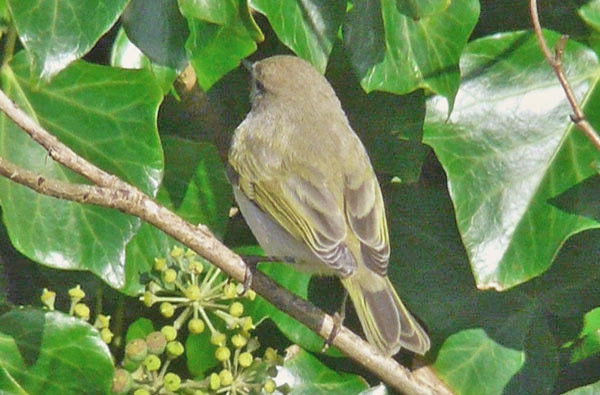
Plate 2d
© A. R. Dean
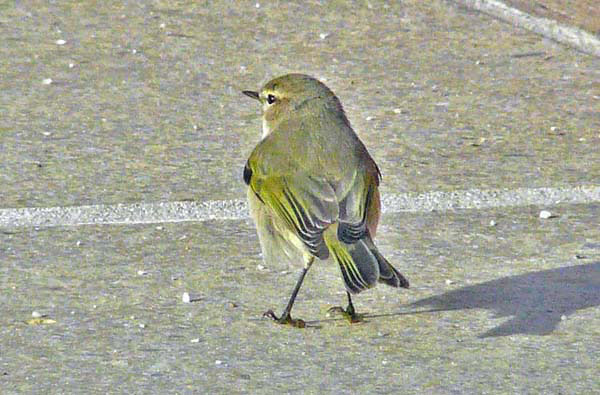
Plate 2e.
© A. R. Dean

Plate 2f. Enlarged detail. Note the well-contrasting upper eyering, with an evident yellow tinge.
© A. R. Dean
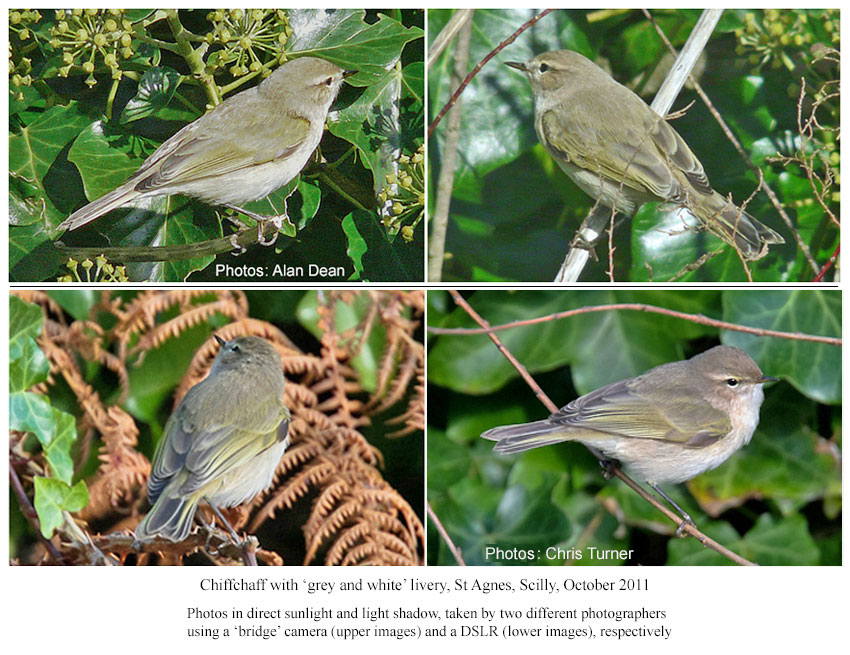
Plates 3a & 3b.
© A. R. Dean (upper photos) & Chris Turner (lower photos)

Plate 4. Siberian Chiffchaff compared with 'grey and white' Chiffchaff, Scilly, October 2011. The plumages of these two are clearly divergent.
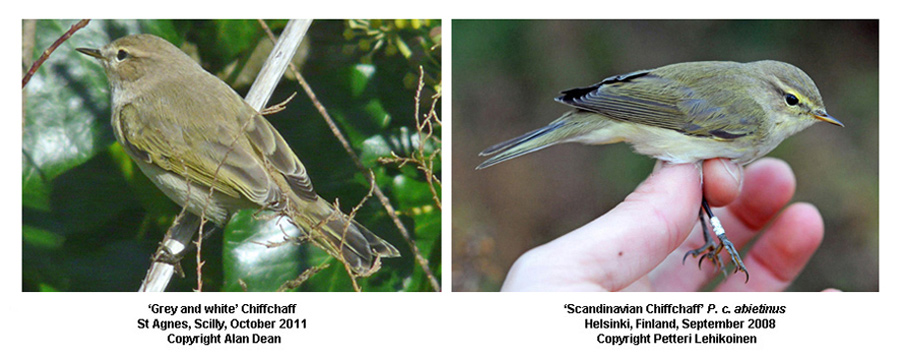
Plate 5. 'Grey and white' Chiffchaff, Scilly, October 2011 compared with abietinus, Finland, September 2008. The plumage hues of these two are clearly convergent.
|
|